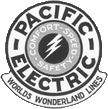Pacific Electric
Terminal Island Line
Background:
This line was a war baby, having been brought into existence to carry shipyard workers to Calship yards on Terminal Island. It operated for the duration of World War II and then, having fulfilled its reason for existence, was abandoned and removed. This line was strictlly an emergency item; it was built in haste; it was built largely of used material; its cars were rescued from the scrap pile; it never reached the degree of public acceptance its proponents had hoped for. Nevertheless, it provided the Southern District with some of its all-time heaviest and most impressive trains and equipment brought to operated this line remained to stamp its insigne on Los Angeles County's postwar electric railway picture.
Route:
From a junction with Long Beach-San Pedro Line at Island Junction (3.51 miles from Long Beach, 19.84 miles from Los Angeles) This line proceeded (double track, private way) via Ford Avenue and the Terminal Island Bridge to a point adjacent to the main entrance of the California Shipbuilding Corporation's ship building yard, where it terminated in a four-track yard 6.30 miles from Long Beach, 22.63 miles from Los Angeles.
History:
The Terminal Island Railway was a creature of abnormal times, but it was built well (although hurriedly) by PE's time-tested personnel. Built to replace the original electric train-ferry service operated from Los Angeles and Long Beach to the Catalina Terminal, Wilmington, the Terminal Island Railway and its trains were owned by the United States Maritime Commission, although employees and operators of the line were all PE personnel.
Construction began in August of 1942 and the work was pressed forward with all haste. At the peak of construction, about 300 men were on this job. The line required three new junctions (Flint Junction and Pioneer Junction to get USMC tains from the San Pedro via Dominguez Line onto the Long Beach-San Pedro Line, and Island Junction—a double track wye—to get them from the Long Beach-San Pedro Line onto the Terminal Island Railway), a new substation (electrical equiptment for which came from dismantled IER facilities in San Francisco), a new tower (at Island Junction) with CTC (which could control at peak hours as many as nine different trains on six different railroads), a unique roadbed (laid for a mile on top of pavement on Henry Ford Avenue) and a special trolley wire lowering device on the drawbridge (which prevented the wire from being cut as the huge counterweights descended whenever the bridge was opened). Opening day was set for March 15, 1943, but delay in arrival of track crossings from Seattle postponed the opening until March 19th.
All during the war the operator at the Island Junction Tower heard the familiar signal over his loudspeaker from trains desiring to be switched onto the Terminal Island trackage (one long whistle, one short). The trains rolled down from Los Angeles in five car cuts, and came over from Long Beach in three-car units—their steel helmeted passengers benefitting from reliable, low cost transportation so necessary to conserve rubber tires.
With V-E and V-J Days came the end for the Terminal Island Railway. The last car ran onto the Island on September 16, 1945, and work began shortly thereafter on removing all vestiges of this railway. Today all that is left to remind one of busy days of only yesterday is the shell of the prosaic substation building, standing by itself amid a forest of busily pumping oil wells.
Equipment:
This line was served throughout by USMC cars, the former IER-SP cars of the Oakland-Alameda-Berkeley electrification. These bore the USMC name on their letterboards and were numbered in their old IER-SP numbers (300-400-625 Classes).
Track:
Trackage unique to this line was of 90 lb. T-rail, laid on redwood ties with crushed rock ballaStreet Special work came from far and near, wherever USMC could find same. In contrast, the latest type of electric powered switch machines were installed.
Electrical Facilities:
Same as Long Beach Domingues Line and Long Beach-San Pedro Line plus one permanent substation housing a mercury arc rectifier (a new portable substation—USMC 00187—handled power requiremets until the permanent sub was finished).
Car Storage:
Same as above three lines. No cars were stored on Terminal Island except during shift workings.
Freight:
None
Passengers:
Figures unavailable
Miscellaneous:
Although short in length, this line presented many unusual problems in regards to railroad and pipeline crossings. Eight railroad crossings had to be negotiated, and several pipelines had to be buried six feet deep to permit the heavy trains to cross them in safety, one Santa Fe and two Union Pacific crossings were controlled from Island Junction Tower, but the others required 10 mph speed limits.
This line was double track throughout except for a stretch of single track crossing the drawbridge onto the island. Track was entirely on private way.
The four-lane Henry Ford Avenue, main vehicular entrance onto the island, lost two lanes for the duration. Heavy wood beams created a curb down the middle of the highway, behind which ballast and ties were installed, the ties being installed by grouting bolts to the pavement.
The Flint Junction-Pioneer Junction trackage is still in service for freight only, the last surviving rail memento of the Terminal Island Railway.
At almost the same spot that once served as the terminal yard on the island, were red and yellow cars which served Los Angeles well and now have long ago been scrapped or sold to other countries. Several hundred PE and LATL cars have been dismantled on Terminal Island including: PE 950s, 1000s, 1600s, 5050 Classs cars as well as some 300s and 400s—plus LARy Standards, H-4s and other types.
Return to ERHA homepage
